Abstract
In this work, density functional theory (DFT)-based first-principles investigations are performed by Generalized Gradient Approximation (GGA) with the Perdew–Burke–Ernzerhof (PBE) functional in the CASTEP code. These simulations provide the insights of the structural, electronic, optical, thermodynamic, mechanical and hydrogen storage gravimetric ratios of lithium-based tetrahydrides (LiBH4, LiAlH4, and LiMnH4) for hydrogen storage and photovoltaic (PV) applications. All these structures crystallize in orthorhombic Cmcm (No. 63) geometry with different lattice parameters and bonding strengths. Thermodynamic stabilities of hydrides are obtained by dispersion of phonons and phonon density of states. The measured band gaps of hydrides are 3.81 eV (LiBH4), 4.60 eV (LiAlH4), and 0.53 eV (LiMnH4), which are calculated by GGA-PBE approach. Moreover, the optical characteristics with strong optical activity are observed from visible to ultraviolet (2 eV to 6 eV) regions. High dielectric response between 6 and 8 and absorption coefficient up to 105 cm−1 for hydrides are observed. Debye temperature has exceeded from 300 K to 600 K for all hydrides and saturation occurred closer to Dulong–Petit limit ~75 J mol−1 K−1. Mechanical stability in hydrides has been observed by Born-Hung mechanical stability criterion, demonstrating ductile nature. These natural hydrides have shown exceptional hydrogen storage capacities, as 18.5 wt% for LiBH4, 10.6 wt% for LiAlH4, and 6.1 wt% for LiMnH4, are measured; these values have exceeded the U.S department of energy (DOE) targets (5.5 wt% H2). These analyses prove that LiXH4 (X = B, Al, Mn) hydrides are promising candidates for solid state hydrogen storage materials.
1. Introduction
During previous years, the global consumption of fossil fuels has increased rapidly at an alarming rate, and classical fuels such as coal, oil, and natural gas have been consumed very rapidly, which has caused environmental and health issues [,]. Consumption of such fuels is the main reason for the release of harmful gases in the environment like carbon dioxide (CO2), sulfur dioxide (SO2), hydrogen sulfide (H2S), nitrous oxides (NOX), carbon monoxide (CO), methane (CH4), and volatile organic compounds []. Such pollutants have caused continuous emission of harmful products in environment, resulting in serious threats to human life and the natural environment like causing air pollution, cardiovascular problems, respiratory diseases, varying global warming and intensifying the greenhouse effects. Also, the earth’s temperature is rising above average, causing the rapid melting of glaciers, increasing sea levels, and the occurrence of acidic rains. Not only this, but it is also causing climate changes, like more frequent and extreme weather events, such as prolonged heatwaves, heavy rainfalls, floods, and unpredictable seasonal shifts [].
Another major challenge associated with the choice of fossil fuels is that they are non-renewable in nature. These resources take millions of years to form but human consumption depletes them at a very rapid rate. At such a rapid consumption rate, the world may face a shortage of energy in the near future. These environmental and economic concerns have created a global urgency to discover alternative energy systems that are sustainable, renewable, and environmentally friendly []. Among different available energy sources, hydrogen emerges as one of the cleanest and most promising candidates for renewable energy sources. Hydrogen not only is present as the most abundant alternative in this universe but it also has an exceptionally high gravimetric energy density of about 120 MJ/kg, which is nearly three times higher than that of conventional fossil fuels. Not only this, but also the combustion of H2 gives water as a byproduct, making it a completely clean fuel with zero carbon emissions [].
Hydrogen-based energy systems hold exceptional potential in a wide range of applications, such as stationary power generation, portable electronic devices, and most importantly transportation technologies such as fuel-cell vehicles. However, despite its many advantages, the biggest challenge is the practical storage of hydrogen, as it has very low volumetric density under ambient conditions, making it very difficult to store and transport in a compact, safe, and cost-effective manner. Various technologies have been developed to overcome this challenge including high-pressure gas cylinders, cryogenic liquid hydrogen tanks, and solid-state storage. Solid-state storage is considered as the most promising approach, particularly due to the use of metal and complex hydrides. It has gained significant attention for offering higher volumetric and gravimetric storage capacities, safer handling, and potential for reversible hydrogen release under moderate operating conditions [,,].
Recent DFT-based studies on hydrogen storage systems and alloy-based hydride systems have reported significant progress. Materials like KNaMg2H6 and KNaCa2H6 have gained significant interest because they have presented hydrogen storage capacities of around 5.19 wt% and 4.09 wt%, respectively. Not only this, but these materials have also exhibited semiconductor nature with moderate band gaps; their hydrogen desorption temperatures lie around 470 K, and they demonstrate a mix of ionic and covalent bonding. These features collectively make them strong candidates for practical hydrogen storage applications []. Another interesting compound of this category of hydrides is LiInH3, which belongs to the family of perovskite hydrides. Being a natural hydride, it offers a gravimetric ratio of around 2.42 wt%, which seems to be less, but it provides a balance between stability and storage performance, making this compound an attractive option among next-generation hydrides. Moreover, DFT analyses indicate that it maintains dynamic stability while exhibiting a metallic nature along with antiferromagnetic properties []. Beyond perovskites, there are some other high-entropy alloys (HEAs), which represent different pathways for hydrogen storage. Compositions like TiZrHfScMo and TiZrHfVNb can reversibly absorb hydrogen up to ~2.7 wt%. One of the key advantages of using such materials is their structural flexibility and structure distortion, which not only enhances hydrogen absorption but also improves the resistance against degradation during repeated cycles. Such features make these HEAs strong candidates for long-term hydrogen storage applications [].
Based on above studies, detailed DFT-based calculations have been performed to study LiXH4-type complex hydrides (X = B, Al, and Mn), in order to investigate their structural, optoelectronic, and thermodynamic properties in CASTEP code, and mechanical properties are measured by Forcite code. Being natural hydrides, their hydrogen storage capacities are calculated by estimating gravimetric ratio for the particular interest as efficient solid-state hydrogen storage materials. These LiBH4, LiAlH4, and LiMnH4 hydrides basically consist of light-weight metal like Li (Lithium), which can result in high gravimetric ratios when combined with light-weight B, Al as well as Mn. Moreover, the inclusion of Mn introduces transition-metal d-orbital interactions, which can significantly influence the electronic structure and can prove beneficial for photovoltaic activity. By combining these approaches, the aim of this study lies in providing a detailed understanding for the intrinsic characteristics of LiBH4, LiAlH4, and LiMnH4, and finally assessing their suitability as potential candidates for next-generation hydrogen storage technologies.
2. Methodology
In this study, a first-principles method of DFT in CASTEP code [] was implemented. To consider exchange–correlation interactions between electronic properties, Generalized Gradient Approximation (GGA) [] as proposed by Perdew, Burke, and Ernzerhof (PBE) [] was employed. This choice of this functional enables us to provide an effective comparison between computational performance, reliable accuracy and efficiency in describing electronic structure, bonding characteristics and atomic populations of LiXH4 (X = B, Al, Mn) hydrides. Moreover, core and valance electronic interactions were taken into account by considering Vanderbilt’s ultrasoft pseudopotentials [], which reduce the required plane-wave basis set size without compromising accuracy. All the structures were fully optimized by employing the Broyden–Fletcher–Goldfarb–Shanno (BFGS) minimization algorithm [], which ensures the convergence towards the lowest energy configuration. During this process several convergence parameters were applied; the self-consistent field (SCF) tolerance was set to 2.0 × 10−6 eV/atom, the maximum force on atoms was restricted to 0.05 eV/Å, the maximum displacement of atoms was restricted to 0.002 Å, and the maximum residual stress was limited to 0.1 GPa. For sampling of Brillouin zone, a 7 × 6 × 7 Monkhorst–Pack k-point mesh was utilized, while the plane-wave cutoff energy was fixed at 700 eV to achieve accurate total energy and electronic property predictions. Relativistic effects were incorporated by applying the Koelling–Harmon approach [], which accounts for scalar relativistic corrections to the electronic states. In addition to evaluating structural and optoelectronic properties, density functional perturbation theory (DFPT) [] was used to calculate thermodynamic behavior of the compounds. Finally, Forcite module was implemented to determine the independent elastic constants, which further helped to calculate mechanical properties such as bulk modulus, shear modulus, Young’s modulus, and Poisson’s ratio through standard theoretical formulations. Altogether, these computational settings have provided a comprehensive framework for analyzing the structural stability, optoelectronic, thermodynamic properties, and mechanical behavior of LiBH4, LiAlH4, and LiMnH4 compounds.
3. Results and Discussion
3.1. Structural Properties
All the LiXH4 (X = B, Al, Mn) compounds possess orthorhombic symmetry and crystallize in Cmcm space group of international number (IT) of 63. The obtained lattice parameters and unit cell volume details of hydrides are provided in Table 1. Unit cell structural representation is shown in Figure 1. There is a slight difference in the lattice parameters of these compounds due to the influence of different X-site elemental substitutions. Atomic positions of Li, X and H within these structures are defined by using Wyckoff sites and fractional coordinates. For Li, there are a total of four positions, one of which occupies 4c Wyckoff position with coordinates (½, 0.9263, ¾), while the X-site atoms (B, Al, Mn) are located at the 4c position with fractional coordinates (½, 0.3223, ¼). Hydrogen atoms are distributed over two nonequivalent sites: the 8f and 8g with fractional coordinates of (½, 0.1758, 0.5472) and (0.7994, 0.9511, ¾) respectively. This combination forms a stable arrangement within the unit cell structures as lighter hydrogen atoms are surrounded by metal clusters, which is beneficial for enhancing hydrogen storage capacities of these hydrides.

Table 1.
Lattice parameters and volume of LiXH4 (X = B, Al, Mn) compounds.
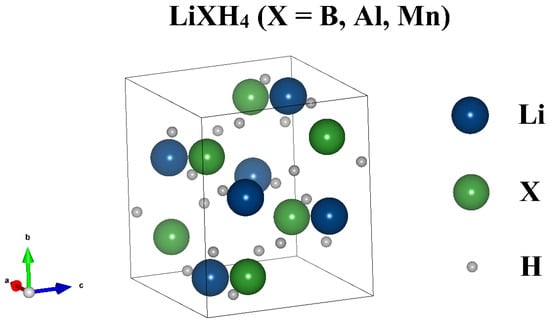
Figure 1.
Demonstration of the unit cell of LiXH4 (X = B, Al, Mn) compounds.
In order to obtain the dynamic stability of these compounds, phonon dispersion curves and phonon density of states of these hydrides are measured and presented in Figure 2 and Figure 3, respectively. No imaginary frequencies are observed for these compounds across the Brillouin zone, especially near the Γ-point, confirming the dynamic stability of these compounds. Moreover, there exist a total of eighteen phonon modes, out of which three are acoustic and fifteen are optical modes []. The acoustic modes are mainly due to Li and X-site atoms, which are clearly separated in the optical branches at higher frequencies. This clear division between acoustic and optical modes reflects strong lattice stability and underlines the suitability of these materials for hydrogen storage and optoelectronic applications. Furthermore, phonon DOS spectra also confirm dynamic stability of all these compounds with no negative frequencies.
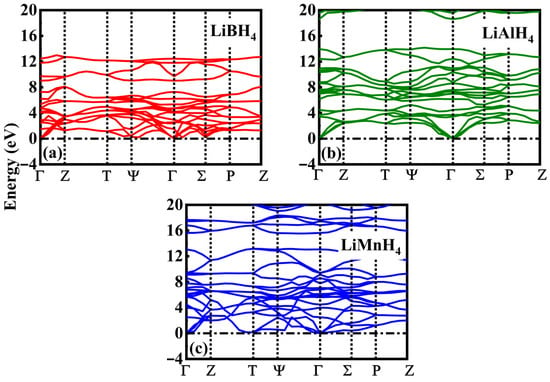
Figure 2.
Phonon dispersion plots of (a) LiBH4, (b) LiAlH4, and (c) LiMnH4 compounds.
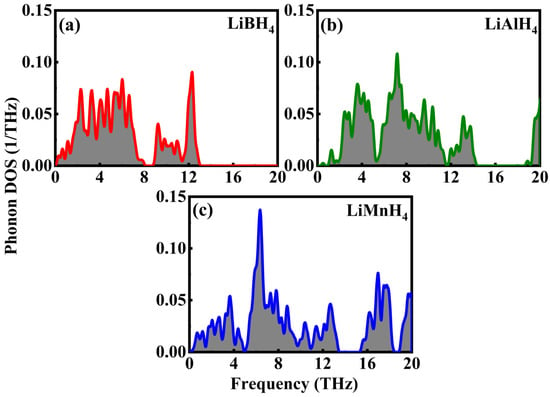
Figure 3.
Phonon density of states (DOS) of (a) LiBH4, (b) LiAlH4, and (c) LiMnH4 hydrides.
A detailed comparison of Mulliken and Hirshfeld charge analyses and population analyses [] is provided in Table 2, which provides information regarding the bonding nature of LiXH4 (X = B, Al, Mn) compounds. Among these compounds, hydrogen is the one which only carries negative charges, while lithium and the central X-atoms (B, Al, Mn) exhibit positive charges, indicating a significant charge transfer from Li and X to H. Such electronic distributions indicate that hydrogen mostly behaves as anionic species, which can be favorable for hydrogen storage. Lithium ions show ionic characteristics, acting as electron donors possessing positive charges across all the compounds, while X-site elements show varying degrees of positive charge depending on their electronegativity and orbital hybridizations. In LiBH4, there exist some more ionic–covalent characteristics due to presence of relative smaller positive charge on boron alongside negatively charged hydrogen, and B–H interactions are responsible for such covalence. In case of LiAlH4, aluminum exhibits more of a positive charge as compared to boron, indicating stronger polarization of Al–H bonds with enhanced covalent interactions. Lastly for LiMnH4 hydride, Mn shows highest value of Mulliken charge due to involvement of d-orbital, resulting in strong ionic character coupled with localized covalent interactions with hydrogen. Overall, the consistency between positive charges of Li and X-site atoms along with negative H-ions confirms the stability of these compounds and a balance between ionic and covalent bonding, which highlights their structural robustness and hydrogen storage capability.

Table 2.
Mulliken and Hirshfeld charge analyses of LiXH4 (X = B, Al, Mn) compounds.
Furthermore, to understand the bonding behavior, electronic localization potential (ELP) analyses of these hydrides are performed and presented in Figure 4a–c. The results confirm strong localization around hydrogen atoms, represented by blue color (values ≈ 1). This indicates that hydrogen atoms within these compounds behave as anions with highly localized electrons. The Li atoms exhibit negligible localization, confirming their strong cationic character, whereas a moderate localization has been observed between X–H bonding regions, indicating a mixed character between X-site (B, Al, Mn) atoms and hydrogen. These features highlight the structure stability of these materials due to stable ionic and covalent characteristics and also indicate the potential of these materials for hydrogen storage applications.
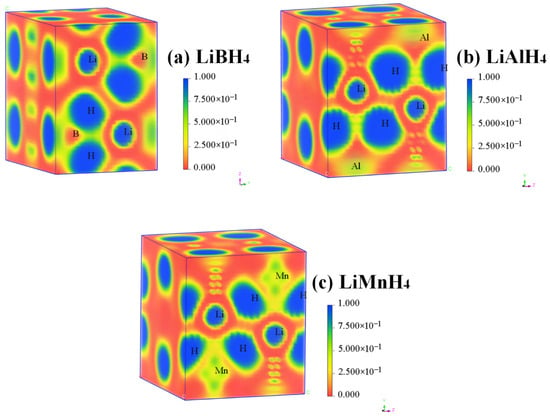
Figure 4.
Electron localization potential, used to describe the degree of polarization and bonding characteristics of (a) LiBH4, (b) LiAlH4, and (c) LiMnH4 hydrides.
3.2. Electronic Properties
Electronic property analysis reveals the band structures of these orthorhombic LiXH4 (X = B, Al, M) compounds, presented in Figure 5a–f. The calculated band gaps of these materials are 3.81 eV for LiBH4, 4.60 eV for LiAlH4, and 0.53 eV for LiMnH4, calculated by GGA-PBE approach. These band gap values confirm that three hydrides are of semiconducting nature. LiBH4 and LiAlH4 have presented wide band gaps, while LiMnH4 possesses a narrow band gap. These variations in band gaps show that substituting the X-site elements can tune the band gap values and the electronic properties. Wide band gap materials (LiBH4 and LiAlH4) are more favorable to be used as insulating layers and charge blocking in energy storage systems; on the other hand the narrow band gap material (LiMnH4) possesses the potential for absorbing visible light, also indicating the facilitation of electron–hole pair generation. In this material, relatively flat valance bands from the Γ to T direction are observed, indicating highly localized electronic states. These localized states arise due to non-bonding of Mn-d and H-p orbitals, which can be seen in the form of limited overlapping along this direction. Such flat electronic states closer to Fermi level give rise to optical absorption in the visible region. Such electronic structure flexibility indicates that these materials have potential for hydrogen storage applications due to their hydride nature, and efficiency for optoelectronic applications such as PV devices.
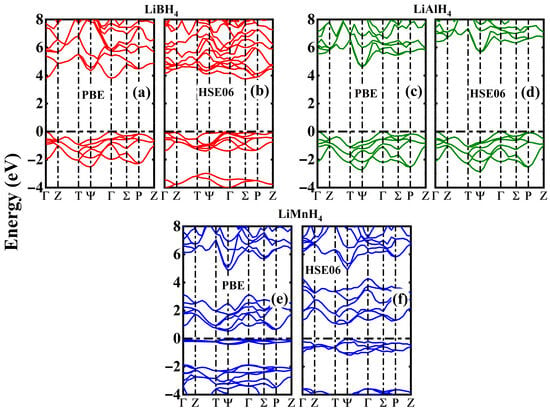
Figure 5.
Band structure plots of (a,b) LiBH4, (c,d) LiAlH4, and (e,f) LiMnH4 compounds.
The GGA-PBE approach often underestimates the band gap values, so the hybrid (HSE06) approach has been employed, which has proven to be more accurate over GGA-PBE. So, the band gaps obtained by using the hybrid approach are 3.91 eV, 5.66 eV and 1.02 eV for LiXH4, where X = B, Al and Mn, respectively. According to this, the band gap value of LiBH4 has turned out to be an insulator, the LiAlH4 band gap lies in a wide band gap semiconductor range, while LiMnH4 has an excellent band gap value required for the optoelectronic applications.
Figure 6 represents the density of states (DOS) plots of these hydrides, which provide more understanding of the electronic properties of these materials. Wider band gap materials show clearer forbidden energy region near the Fermi level, confirming the band structure of these compounds. In contrast LiMnH4 exhibits higher densities near Fermi level with a narrow region of forbidden energies. Such larger densities near Fermi level suggest stronger light matter interactions, which is beneficial for enhanced optoelectronic activity. Overall, the DOS analyses confirm that the electronic properties of LiXH4 compounds are well suited for dual applications in hydrogen storage and optoelectronic technologies.
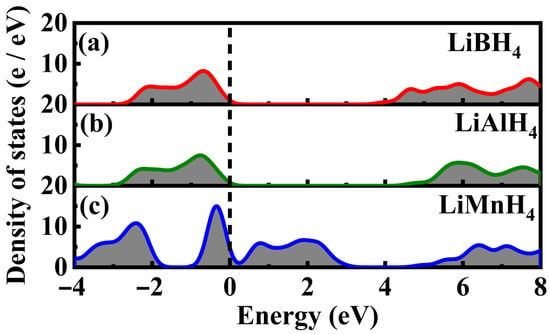
Figure 6.
Density of states (DOS) plots of (a) LiBH4, (b) LiAlH4, and (c) LiMnH4 compounds.
In order to further understand the electronic properties of these hydrides, partial density of states (PDOS) analyses of all these compounds are measured and depicted in Figure 7. In Figure 7a, PDOS analysis of LiBH4 is presented, where the majority of contributions in making the valance band come from the H-atom, specifically H-1s1 and B-2p1 orbitals, while lithium lacks any densities in the valance band. On the other hand, in the conduction band a larger gap is present close to Fermi level of 0 eV, corresponding to the material’s wider band gap. After that the major contribution comes from the p orbital of Li-2p1, which is the result of hybridization and B-2p1. In Figure 7b, PDOS plots of LiAlH4 hydride are presented, whose valance band is significantly contributed by H-1s1 and Al-3p1 orbitals, while on the other hand, for the conduction band there also exists a wider band gap, which is represented by the absence of densities close to Fermi level. After that the contributions of Li-2p1 and Al-3p1 orbitals are clearly visible. Lastly, PDOS plots of LiMnH4 are presented in Figure 7c, showing the significant influence of d-orbitals in the valance band closer to Fermi level. The Mn-3d5 orbital presents the major contribution, with a minor contribution by the H-1s1 orbital. On the other side of Fermi level, for the conduction band the Mn-3d5 orbital contributes significantly, with a minor contribution by the Li-2p1 orbital.
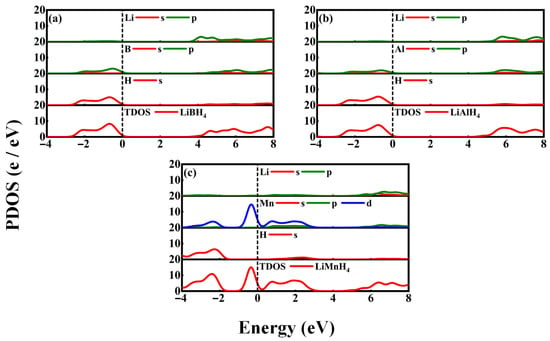
Figure 7.
Partial density of states (PDOS) plots of (a) LiBH4, (b) LiAlH4, and (c) LiMnH4 compounds.
3.3. Optical Properties
Optical properties of the materials are essential to evaluate the potential of compounds for optoelectronic applications and hydrogen storage capacities. Optical properties of these materials are presented in Figure 8 and Figure 9. Complex dielectric function, described by real and imaginary parts, is mentioned by Equation (1), which is very important to understand, as it describes the polarization and absorption of incident light within the material. In Equation (1), there exist two different quantities, imaginary and real portions of dielectric function, which are described by Equations (2) and (3), respectively [,].
ε(ω) = ε1(ω) + iε2(ω)
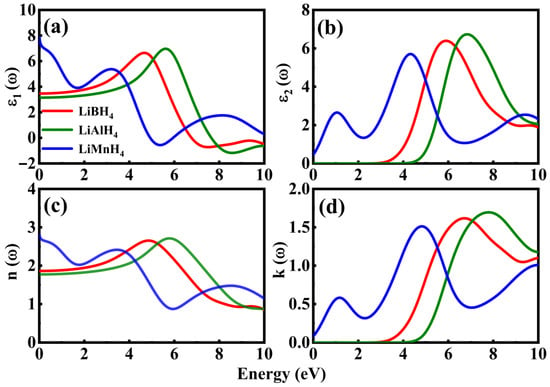
Figure 8.
Comparison of calculated optical parameters like (a) real part of the dielectric function, (b) imaginary part of the dielectric function, (c) refractive index, and (d) extinction coefficient of LiXH4 (X = B, Al, Mn) compounds.
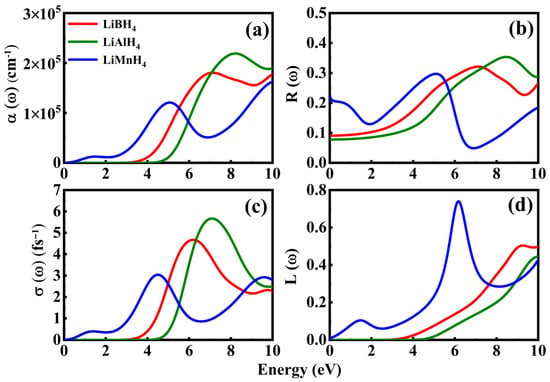
Figure 9.
Comparison of investigated optical parameters (a) absorption coefficient, (b) reflectivity, (c) optical conductivity, and (d) energy loss function of LiXH4 (X = B, Al, Mn) compounds.
The imaginary portion of the dielectric function is measured by Equation (3), where are the wave functions of conduction and valance bands at k-point, respectively, and the energies associated to them are known as energy of conduction () and valance () bands of V unit cell volume; is the reduced Plank’s constant, e is the electronic charge, m is electronic mass and ω is the frequency of the incident photon. This is essential to understand, as all other optical properties, including refractive indices, (refractive index and extinction coefficient), optical conductivity. absorption, reflectivity and loss function are related to this through the use of Equations (4)–(9) [,,,].
Figure 8a represents the comparison of real parts of the dielectric function of LiXH4 (X = B, Al, Mn) compounds, where it is clear that LiMnH4 compound shows a high static value of about 7.4, which is due to its narrow band gap of about 0.53 eV; lower than this is the static value given by LiBH4 compound of about 3.47, and below this the LiAlH4 compound value is 3.14. An interesting fact can be observed here; the static value of LiMnH4 compound seems to be higher than the peak values of all other compounds, as LiBH4 and LiAlH4 compounds show peak values of about 6.65 and 6.97, respectively. All the materials show negative values of the real part of the dielectric function at higher energy of incident radiation, indicating that each of these materials behaves as transparent in the far UV region. Figure 8b represents the imaginary part of the dielectric function in the energy range of 0–10 eV, with LiMnH4 hydride having a narrow band gap, so its imaginary part of the dielectric function emerges closer to 0 eV, while the other two hydrides show threshold values corresponding to their band gap values. After passing their band gap values, imaginary parts of their dielectric function tend to rise towards their peak values, with the highest value shown by LiAlH4 of about 6.73; lower than this is reported for LiBH4 compound, with a peak value of about 6.39, and in last is LiBH4 compound, with a peak value of about 5.70, all these peak values lie after 4 eV indicating higher absorption in this region. Such high values of the real part of the dielectric function indicate strong polarization under the influence of the electric component of electromagnetic radiation, indicating that these hydrides possess strong potential for PV applications and optoelectronic devices.
Refractive index versus energy (eV) plots are presented in Figure 8c with static values approaching 2.83 for LiMnH4, 1.86 for LiBH4, and 1.77 for LiAlH4; the highest value is reported for the compound with the narrowest band gap. Furthermore, the peak values for LiAlH4 and LiBH4 compounds are 2.71 and 2.65, respectively. Values of refractive index approach 1, in the same region where the materials show negative values of the real part of the dielectric function, also indicating transparency by n = 1 value of refractive index. Figure 8d represents the extinction coefficient, whose behavior is similar to imaginary part of the dielectric function, with materials’ threshold values starting after their band gap values. One noticeable fact is that LiMnH4 shows a narrow band gap of about 0.53 eV but its value emerges from 0 eV; this is due to the fact that the d-orbital of Mn, which was observed by DOS and PDOS, greatly influences its electronic and optical properties due to higher densities closer to Fermi level. Hence, these factors enlarge the extinction coefficient as well as the imaginary portion of the dielectric function. The peak values of extinction coefficient for LiXH4 (X = B, Al, Mn) hydrides are 1.62, 1.70 and 1.61, respectively, indicating strong potential for PV devices and hydrogen storage capacities.
LiMnH4 compound, compared to LiBH4 and LiAlH4 compounds, shows additional peaks in optical spectra, and the possible reason for this is due to inter-band transitions involving Mn-d orbitals. Moreover, previously discussed in PDOS analysis, the valence band of LiMnH4 is mainly composed of Mn-d and H-p states, while the conduction band is dominated by Mn-d and Li-s states. Such interactions lead to strong d–d and p–d transitions, resulting in extra peaks in ε1(ω), ε2(ω), n(ω), and k(ω).
In Figure 9a optical absorption of hydrides is presented, with maximum values approaching above 105 cm−1. Among all hydrides, LiAlH4 hydride has shown the highest α(ω) value of about 219,033 cm−1. The peak values for LiBH4 and LiMnH4 are 179,133 cm−1 and 120,672 cm−1, respectively. Such high values of absorption coefficient in the visible to UV regions of incident radiation indicate that they contain potential for PV applications. Reflectivity is described by the percentage of how much incident radiation is reflected back by materials; outcomes of the hydrides under study are given in Figure 9b. At static point (reflectivity at 0 eV), narrow band gap hydride shows the highest value of about 21%, while the other two hydrides remain less than 10% in this region. Maximum values can be observed after 5 eV by these hydrides, with 30% for LiMnH4, 35% for LiAlH4, and 32% for LiBH4. Specifically discussing the visible region, the lowest reflectivity is observed for LiAlH4 (9.5%), and also a little higher value of 12% is observed for LiBH4, which are suitable for PV devices. Optical conductivity is also another important optical property and the outcomes for the compounds under study are presented in energy range of 0–10 eV (Figure 9c). The highest values of 5.7 fs−1 for LiAlH4, 4.7 fs−1 for LiBH4 and 3.1 for LiMnH4 indicate strong potential for optoelectronic applications and PV devices. Moreover, the threshold values for these hydrides emerge from energies after their band gap values. Finally, we have the loss function spectra for all hydrides under study; they are presented in Figure 9d, with threshold values emerging after their band gap values. The highest peak values are reported for LiMnH4, reaching about 0.74, while for the other LiBH4 and LiAlH4 hydrides, the peak values are about 0.50 and 0.43, respectively. These peak values correspond to plasmon resonance and interband transitions.
3.4. Thermodynamics Properties
The thermodynamic properties of the hydride materials under study are investigated by DFPT approach, including enthalpy, free energy and T*Entropy. These properties are dependent on phonon density of states (N(ω)) described by the set of Equations (10)–(12) [], where ℏ is the reduced Planck’s constant, Ezp is known as zero-point, and kB is Boltzmann’s constant. Ezp is also estimated during the simulations and showed values of 2.02 eV for LiBH4, 1.65 eV for LiAlH4, and 1.43 eV for LiMnH4. These positive values of Ezp (zero-point energy) indicate the highly thermodynamic stability of more tightly bound hydrogen due to stronger lattice interactions.
In discussing the thermodynamic properties, quantities like enthalpy and T*Entropy increase with temperature, but the free energy decreases with increasing temperature in the range of 0 to 1000 K; these are presented in Figure 10. This decrease in free energy is due to the fact that at higher temperatures, entropy of the system increases, which leads to a decrease in free energy of the system, as given by Equation (13) []
F = H − TS
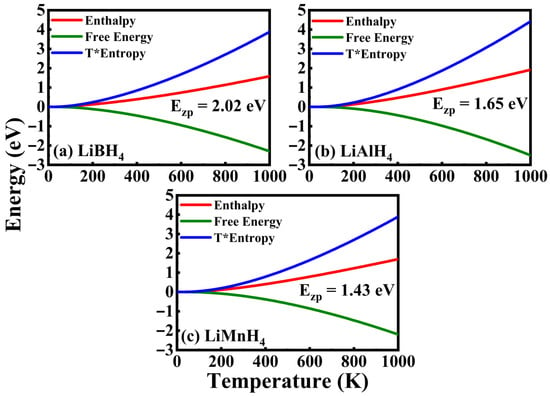
Figure 10.
Temperature-dependent thermodynamic properties including enthalpy, free energy and T*Entropy of (a) LiBH4, (b) LiAlH4, and (c) LiMnH4 compounds alongside their zero-point energy.
A sharp increase in the T*Entropy profiles has been observed for the hydrides under study, which is more visible from 300 K to 600 K; this increase is considered good for hydrogen desorption under practical conditions. On the other hand, the free energy slope shows a decrease at elevated temperatures, which also indicates the release of hydrogen, demonstrating the thermodynamic stability at elevated temperatures. All of these thermodynamic properties show strong dynamic stability for these compounds, indicating strong potential for solid-state hydrogen storage alternates under controlled thermal conditions. Heat capacity at constant volume (CV) as a function of temperature is presented in Figure 11, over the temperature range of 0–1000 K, which is obtained by using Equation (14). The hydrides under study show an increase in CV as temperature increases and all compounds show saturation near their Dulong–Petit limit of ~75 J mol−1 K−1 (dashed line Figure 11), which is the point of full excitations for all thermal modes. Such behavior is related to good thermal response for all hydride materials, supporting their suitability for hydrogen storage applications under practical conditions [].

Figure 11.
Heat capacity plots at constant volume CV for (a) LiBH4, (b) LiAlH4, and (c) LiMnH4.
Debye temperature versus temperature range 0–1000 K plots are presented in Figure 12. From Figure 12, it is clear that LiBH4 exhibits a higher value than other hydrides at higher temperature, indicating its stronger interatomic interactions, but it is low as compared to other hydrides at low temperature, and at higher temperatures, the lowest value is shown by LiAlH4.
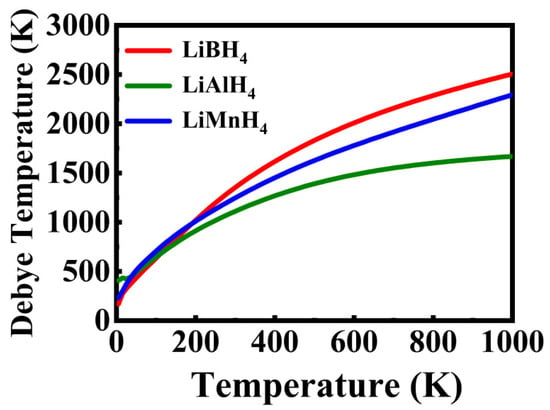
Figure 12.
Debye temperature plots of LiXH4 (X = B, Al, Mn) hydrides.
3.5. Mechanical Properties
The elastic constants of each hydride are essential to investigate in order to investigate their mechanical stability and elastic properties, including Cauchy pressure, different modulus, and Poisson’s ratio. LiXH4 (X = B, Al, Mn) hydrides possess orthorhombic geometry, so the Born-Hung stability criterion will be employed for orthorhombic crystal systems; this is described using the set of Equations (15)–(19) [,].
C11 > 0, C22 > 0, C33 > 0, C44 > 0, C55 > 0, C66 > 0
C11 + C22 − 2C12 > 0
C11 + C33 − 2C13 > 0
C22 + C33 − 2C23 > 0
C11 + C22 + C33 + 2C12 + 2C13 + 2C23 > 0
The investigated values of elastic constants are provided in Table 3, from which the calculated mechanical stability of these compounds is also provided; all these hydrides are mechanically stable, as they satisfy the Born-Hung stability criterion for orthorhombic crystals. Moreover, Cauchy pressure values are also provided in this Table 3; these give information about the materials’ ductile or brittle natures. As the values of Cauchy pressure for the hydrides are positive, it can be concluded that all hydrides are ductile in nature. The elastic constants of compounds are used to further estimate the mechanical parameters, like various moduli and Poisson’s ratios, which are provided in Table 4; these values obtained using Equations (20)–(23) [,]. These calculated values show significant difference in mechanical behavior of each LiXH4 (X = B, Al, Mn) hydride. The LiBH4 compound shows the highest values for all moduli, i.e., Young’s modulus (50.140 GPa), shear modulus (17.136 GPa), and bulk modulus (225.855 GPa), indicating its higher stiffness and resistance to deformation, as compared to other hydrides. In contrast, the values of moduli for LiAlH4 and LiMnH4 hydrides are low, indicating their soft nature as compared to LiBH4. Poisson’s ratios of compounds also estimate the brittle/ductile natures, with values less than 0.22 [] indicating brittle, while values above 0.22 indicate a ductile nature. The calculated values are 0.4630 for LiBH4, 0.4962 for LiAlH4, and 0.4326 for LiMnH4, respectively, which are above 0.22; this limit indicates the ductile nature of these materials, which is consistent with Cauchy pressure results. Overall, these results suggest that all these materials are mechanically stable and possess ductile natures, making them good for hydrogen storage and PV applications.

Table 3.
Calculated independent elastic constant Cij (GPa) values required for orthorhombic geometry, stability conditions and Cauchy pressures of LiXH4 (X = B, Al, Mn) compounds.

Table 4.
Comparison of bulk modulus (B), shear modulus (G), Young’s modulus (E), and Poisson’s ratios (ν) of LiXH4 (X = B, Al, Mn) compounds.
3.6. Hydrogen Storage Capacities
All of the compounds under study are naturally hydrides, so their hydrogen storage gravimetric ratios can be calculated using the Equation (24) [].
The calculated hydrogen gravimetric storage ratios for all compounds easily exceed the U.S. department of energy (DOE) target; this value is 5.5% for on-board hydrogen storage. Among all hydrides, LiBH4 has demonstrated the highest storage capacity of about 18.5 wt%, making it the most promising candidate for hydrogen storage applications. LiAlH4 hydride has also shown a high capacity of 10.6 wt%, while LiMnH4 hydride has shown a value 6.1 wt%, above the DOE target (Table 5). Overall, it can be concluded that all of these hydrides exceed the hydrogen storage limit indicated by DOE, making them excellent candidates for efficient hydrogen storage materials.

Table 5.
Comparison of gravimetric hydrogen storage ratio (H wt%) of LiXH4 (X = B, Al, Mn) compounds.
Among all the comparative materials, LiBH4 hydride has achieved the highest value (Table 6), as its gravimetric ratio is very high compared to others. Not only this, but the other hydrides under study have also shown high gravimetric ratios, indicating strong potential for hydrogen storage application.

Table 6.
Comparison of gravimetric hydrogen storage ratio (H wt%) as well as band gap of LiXH4 (X = B, Al, Mn) compounds with some previously discovered hydride materials.
4. Conclusions
This study investigates the potential of LiXH4 (X = B, Al, Mn) hydrides for hydrogen storage capacities and PV applications by analyzing their structural, optoelectronic, thermodynamics, mechanical and hydrogen storage gravimetric ratios by using CASTEP and Forcite codes. All hydrides have exhibited orthorhombic structures, with Cmcm (No. 63) geometry having different lattice parameters, bonding strengths and populations. Electronic property analyses have revealed the existence of band gaps of about 3.81 eV (LiBH4), 4.60 eV (LiAlH4), and 0.53 eV (LiMnH4) and optical analyses have presented high dielectric response between 6 and 8 and absorption coefficient up to 105 cm−1 for all compounds, making them strong candidates for PV technologies. Moreover, for further confirmation, the band structures were measured by the hybrid HSE06 function, and the reported band gaps are 3.91 eV, 5.66 eV and 1.02 eV, respectively. Thermodynamic properties have revealed the dynamic stability of these hydrides, with zero-point energy values of 2.02 eV for LiBH4, 1.65 eV for LiAlH4, and 1.43 eV for LiMnH4, confirming the stability. Compounds have shown a ductile nature based on mechanical property analyses. Most importantly their hydrogen storage capacities (18.5 wt% for LiBH4, 10.6 wt% for LiAlH4, and 6.1 wt% for LiMnH4) have exceeded the DOE target, making them promising candidates for solid-state hydrogen storage applications.
Author Contributions
Conceptualization, A.H. and N.J.; methodology, A.H., A.Y. and A.S.; software, A.Y., A.S. and M.A.Q.; validation, A.H., N.J. and M.A.Q.; formal analysis, A.H., A.Y. and M.A.Q.; investigation, A.Y. and A.S.; resources, A.S., M.A.Q. and N.A.A.; data curation, A.H., A.Y. and A.S.; writing—original draft preparation, N.J., A.S. and M.A.Q.; writing—review and editing, N.J. and N.A.A.; visualization, A.H. and N.A.A.; supervision, N.J. and N.A.A.; project administration, N.J.; funding acquisition, N.A.A. All authors have read and agreed to the published version of the manuscript.
Funding
This research received no external funding.
Data Availability Statement
Data will be made available on request from the corresponding author.
Acknowledgments
The authors would like to acknowledge the Deanship of Graduate Studies and Scientific Research, Taif University for funding this work.
Conflicts of Interest
The authors declare no conflicts of interest.
References
- Al-Shetwi, A.Q. Sustainable development of renewable energy integrated power sector: Trends, environmental impacts, and recent challenges. Sci. Total Environ. 2022, 822, 153645. [Google Scholar] [CrossRef]
- Ukaogo, P.O.; Ewuzie, U.; Onwuka, C.V. Environmental pollution: Causes, effects, and the remedies. In Microorganisms for Sustainable Environment and Health; Elsevier: Amsterdam, The Netherlands, 2020; pp. 419–429. [Google Scholar]
- Inumaru, J.; Hasegawa, T.; Shirai, H.; Nishida, H.; Noda, N.; Ohyama, S. Fossil fuels combustion and environmental issues. In Advances in Power Boilers; Elsevier: Amsterdam, The Netherlands, 2021; pp. 1–56. [Google Scholar]
- Sarfraz, M. Global Warming Cause and Impact on Climate Change. Int. J. Emerg. Knowl. Stud 2024, 3, 198–204. [Google Scholar]
- Freedman, B.; Dorsey, W.; Frazier, A.; Kambhampati, M.; Galiotos, J.; Mukherjee, S. Renewable and Non-renewable Energy Sources. Environ. Sci. 2024. [Google Scholar]
- Rampai, M.M.; Mtshali, C.B.; Seroka, N.S.; Khotseng, L. Hydrogen production, storage, and transportation: Recent advances. RSC Adv. 2024, 14, 6699–6718. [Google Scholar] [CrossRef]
- Rolo, I.; Costa, V.A.; Brito, F.P. Hydrogen-based energy systems: Current technology development status, opportunities and challenges. Energies 2023, 17, 180. [Google Scholar] [CrossRef]
- Gupta, P.; Toksha, B.; Rahaman, M. A critical review on hydrogen based fuel cell technology and applications. Chem. Rec. 2024, 24, e202300295. [Google Scholar] [CrossRef]
- Qasem, N.A.; Abdulrahman, G.A. A recent comprehensive review of fuel cells: History, types, and applications. Int. J. Energy Res. 2024, 2024, 7271748. [Google Scholar] [CrossRef]
- Rehman, M.A.; Rehman, Z.U.; Usman, M.; Alomar, S.Y.; Khan, M.J.; Fatima, J. Exploring the hydrogen storage in novel perovskite hydrides: A DFT study. Int. J. Hydrogen Energy 2024, 84, 447–456. [Google Scholar] [CrossRef]
- Deen, S.M.; Usman, M.; Rehman, J.U.; Ali, S.M.; Ali, M. A DFT study for physical properties and hydrogen storage capability of indium-based hydride perovskites XInH3 (X = Li, K) for hydrogen storage application. Solid State Commun. 2024, 384, 115488. [Google Scholar] [CrossRef]
- Hu, J.; Shen, H.; Jiang, M.; Gong, H.; Xiao, H.; Liu, Z.; Sun, G.; Zu, X. A DFT study of hydrogen storage in high-entropy alloy TiZrHfScMo. Nanomaterials 2019, 9, 461. [Google Scholar] [CrossRef]
- Segall, M.D.; Lindan, P.J.; Probert, M.A.; Pickard, C.J.; Hasnip, P.J.; Clark, S.J.; Payne, M.C. First-principles simulation: Ideas, illustrations and the CASTEP code. J. Phys. Condens. Matter 2002, 14, 2717. [Google Scholar] [CrossRef]
- Perdew, J.P.; Burke, K.; Ernzerhof, M. Generalized gradient approximation made simple. Phys. Rev. Lett. 1996, 77, 3865. [Google Scholar] [CrossRef] [PubMed]
- Perdew, J.P.; Burke, K.; Ernzerhof, M.J.P.R.L. Perdew, burke, and ernzerhof reply. Phys. Rev. Lett. 1998, 80, 891. [Google Scholar] [CrossRef]
- Vanderbilt, D. Soft self-consistent pseudopotentials in a generalized eigenvalue formalism. Phys. Rev. B 1990, 41, 7892. [Google Scholar] [CrossRef]
- Nawi, N.M.; Ransing, M.R.; Ransing, R.S. An improved learning algorithm based on the Broyden-Fletcher-Goldfarb-Shanno (BFGS) method for back propagation neural networks. In Sixth International Conference on Intelligent Systems Design and Applications; IEEE: Jian, China, 2006; Volume 1, pp. 152–157. [Google Scholar]
- MacDonald, A.H.; Picket, W.E.; Koelling, D.D. A linearised relativistic augmented-plane-wave method utilising approximate pure spin basis functions. J. Phys. C Solid State Phys. 1980, 13, 2675. [Google Scholar] [CrossRef]
- Jabeen, N.; Zafar, S.; Hussain, A.; Abdullah, A.I.; Kumar, A.; Ahmad, H. A DFT Analysis on the Electronic, Mechanical, Optical, Elastic, Structural and Thermodynamic Properties of XBiNb2O7 (X= Cs, Rb, K and Na) for Photovoltaic Applications. Comput. Condens. Matter 2025, 44, e01063. [Google Scholar] [CrossRef]
- Pallikara, I.; Kayastha, P.; Skelton, J.M.; Whalley, L.D. The physical significance of imaginary phonon modes in crystals. Electron. Struct. 2022, 4, 033002. [Google Scholar] [CrossRef]
- Reed, A.E.; Weinstock, R.B.; Weinhold, F. Natural population analysis. J. Chem. Phys. 1985, 83, 735–746. [Google Scholar] [CrossRef]
- Kainat, F.; Jabeen, N.; Yaqoob, A.; Hassan, N.U.; Hussain, A.; Khalifa, M.E. Effect of Ca, Ba, Be, Mg, and Sr substitution on electronic and optical properties of XNb2Bi2O9 for energy conversion application using generalized gradient approximation–Perdew–Burke–Ernzerhof. Crystals 2024, 14, 710. [Google Scholar] [CrossRef]
- Griffiths, D.J. Introduction to Electrodynamics; Cambridge University Press: Cambridge, UK, 2023. [Google Scholar]
- Hussain, A.; Jabeen, N.; Yaqoob, A.; Zafar, S.; Khan, M.U.; Ayob, E.A.; Khalifa, M.E. First-principles investigation of diverse properties of X2CaTa2O7 (X= Li, Na, K, and Rb) Ruddlesden–Popper compounds for photovoltaic applications. Crystals 2025, 15, 228. [Google Scholar] [CrossRef]
- Moore, E.A.; Smart, L.E. Optical properties of solids. In Solid State Chemistry; CRC Press: Boca Raton, FL, USA, 2020; pp. 283–314. [Google Scholar]
- Jabeen, N.; Hussain, A.; Hamza, A.; Musa, O.; Beemkumar, N.; Nanda, J. Multifunctional analysis of CaX2Bi2O9 (X= Nb, V, Ta, and Pa) compound by first principles framework for photovoltaic applications. AIP Adv. 2025, 15, 055015. [Google Scholar] [CrossRef]
- Yaqoob, A.; Jabeen, N.; Hamza, A.; Haider, I.; Kainat, F.; Hussain, A. A Theoretical Study for Investigation of Structural, Optical, Electronic, and Mechanical Properties of Double Perovskites Halide for Solar Cell Application. Conclus. Eng. 2025, 1, 72–81. [Google Scholar] [CrossRef]
- Moreira, E.; Barboza, C.A.; Albuquerque, E.L.; Fulco, U.L.; Henriques, J.M.; Araújo, A.I. Vibrational and thermodynamic properties of orthorhombic CaSnO3 from DFT and DFPT calculations. J. Phys. Chem. Solids 2015, 77, 85–91. [Google Scholar] [CrossRef]
- Günther, E.; Hiebler, S.; Mehling, H.; Redlich, R. Enthalpy of phase change materials as a function of temperature: Required accuracy and suitable measurement methods. Int. J. Thermophys. 2009, 30, 1257–1269. [Google Scholar] [CrossRef]
- Hussain, A.; Kainat, F.; Jabeen, N.; Yaqoob, A.; Abbas, T.; Khan, M.U.; Qaiser, M.A.; Mahmoud, M.H.H. First-principles calculations of the structural, mechanical, optical, and electronic properties of X2Bi4Ti5O18 (X = Pb, Ba, Ca, and Sr) bismuth-layered materials for photovoltaic applications. Crystals 2024, 14, 870. [Google Scholar] [CrossRef]
- Born, M.; Huang, K. Dynamical Theory of Crystal Lattices; Oxford University Press: Oxford, UK, 1996. [Google Scholar]
- Ding, Y. Theoretical study on stability, mechanical properties and thermodynamic parameters of the orthorhombic-A2N2O (A=C, Si and Ge). Phys. B Condens. Matter 2012, 407, 2190–2200. [Google Scholar] [CrossRef]
- Hussain, A.; Kainat, F.; Hamza, A.; Naz, A.; Jabeen, N.; Munawar, T.; Qaiser, M.A. A DFT study on the structural, electronic, optical, and elastic properties of BLSFs XTi4Bi4O15 (X = Sr, Ba, Be, Mg) for solar energy applications. Ceramics 2024, 7, 1727–1741. [Google Scholar] [CrossRef]
- Cao, J.; Li, F. Critical Poisson’s ratio between toughness and brittleness. Philos. Mag. Lett. 2016, 96, 425–431. [Google Scholar] [CrossRef]
- Züttel, A. Hydrogen storage methods. Naturwissenschaften 2004, 91, 157–172. [Google Scholar] [CrossRef] [PubMed]
- Hou, Q.; Yang, X.; Zhang, J. Review on hydrogen storage performance of MgH2: Development and trends. Chem. Sel. 2021, 6, 1589–1606. [Google Scholar] [CrossRef]
- Ismail, M.; Zhao, Y.; Yu, X.B.; Mao, J.F.; Dou, S.X. The hydrogen storage properties and reaction mechanism of the MgH2–NaAlH4 composite system. Int. J. Hydrogen Energy 2011, 36, 9045–9050. [Google Scholar] [CrossRef]
- Yaqoob, A.; Hussain, A.; Jabeen, N.; Fallatah, A.M. DFT Study of Physical Properties for A2H3X (A = Sr, Ba; X = Cl, Br) Compounds: Their Possible Applications for Hydrogen Storage and Optoelectronic Devices. Chem. Sel. 2025, 10, e03422. [Google Scholar] [CrossRef]
- Masood, M.K.; Khan, W.; Bibi, S.; Khan, N.; Pingak, R.K.; Tahir, K.; Rehman, J.; Bahajjaj, A.A.A. The structural, elastic, optoelectronic properties and hydrogen storage capability of lead-free hydrides XZrH3 (X: Mg/Ca/Sr/Ba) for hydrogen storage application: A DFT study. Comput. Theor. Chem. 2024, 1242, 114941. [Google Scholar] [CrossRef]
- Pela, R.R.; Hsiao, C.L.; Hultman, L.; Birch, J.; Gueorguiev, G.K. Electronic and optical properties of core–shell InAlN nanorods: A comparative study via LDA, LDA-1/2, mBJ, HSE06, G 0 W 0 and BSE methods. Phys. Chem. Chem. Phys. 2024, 26, 7504–7514. [Google Scholar] [CrossRef] [PubMed]
Disclaimer/Publisher’s Note: The statements, opinions and data contained in all publications are solely those of the individual author(s) and contributor(s) and not of MDPI and/or the editor(s). MDPI and/or the editor(s) disclaim responsibility for any injury to people or property resulting from any ideas, methods, instructions or products referred to in the content. |
© 2025 by the authors. Licensee MDPI, Basel, Switzerland. This article is an open access article distributed under the terms and conditions of the Creative Commons Attribution (CC BY) license (https://creativecommons.org/licenses/by/4.0/).